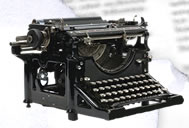Recently Added Articles
Click here to be notified when articles
are added to your favorite categories
| The Spirit of Flappers (NY Times, 1922) Speaking about why she loved the Twenties, Diana Vreeland (1903 – 1989) - observant fashion editor and unique fashion phenomenon, once remarked on a chat show that "there's never been a woman with her clothes chopped off at the knee in history". Indeed - Vreeland would find the attached article about flappers to be spot-on. |
| The Bounteous Land (Literary Digest, 1933) The war clouds may have been gathering over Europe in 1933, but in British Palestine the skies were blue and life was good. Just as this 1922 magazine article intimated eleven years earlier, British Palestine was continuing to flourish in ways that neither the resident Zionists or the overseers from the British Colonial Office ever anticipated: "Two years ago, [British] Palestine's orange crop - its main source of income - filled 2,000,000 cases at most. The forecast for the coming year is 6,000,000. Tel Aviv, a Jewish settlement near Jaffa, had 2,000 inhabitants in 1919. Now it claims 60,000 with 100,000 close ahead..." |
| Witness on Azusa Street (LA Times, 1906) Between 1906 and 1909, the Holy Spirit had come to dwell among the people in Los Angeles. One April day, in a run-down livery stable that was converted to a church, Pastor William Seymore (1870 – 1922) broke out into tongues and so did everyone within earshot. In fact, people blocks away began to speak in tongues and witnessing to all passersby. Within no time, the walls of that "tumble-down shack on Azusa Street" were decorated with the crutches, canes and hearing horns of the recently healed. |
| Prejudice on the Home Front (Look Magazine, 1945) As the Allied Armies were nearing Berlin and Tokyo, U.S. magazines began running articles concerning the nation's problems that had all been put on the back burner during the war years. Subjects of concern involved inflation, alcoholism, and juvenile delinquency. The article attached here concern America's curse: racial and religious prejudice, and how to get rid of it. |
| Rationing on the Germn Home Front (Collier's Magazine, 1940) A weird article. This journalist seemed to admire much of what he saw in Nazi Germany. |
| A Great Cheer from Coast to Coast (PM Tabloid, 1945) An anonymous reporter relays all that came across his desk in the way of wild victory celebrations on VJ Day. Spread out over 14 paragraphs are eyewitness accounts of the pandemonium that spread across the nation when the news arrived that the war was over. |
| An American-Style Concentration Camp (Coronet Magazine, 1942) An optimistic article from 1942 that asks us to look for the sunny side of the Japanese American internment camps - after all, they never had it so good! |
| Howard Johnson's Roadside Restaurants (Coronet Magazine, 1946) By the mid-Twenties millions of cars were on America's highways and by-ways and family road trips were all the rage. However, the few roadside food stands that existed at the time were woefully inadequate and numerous journalists in every locale were writing articles about the various stomach aches that were regularly descending upon hapless motorists who patronized these businesses. This article is about a Massachusetts fellow named Howard Johnson - "Somewhere along the line he figured out that what America needed even more than a good five-cent cigar was a chain of stands that would take the chance out of roadside eating." |
| ''While Brave Men Die'' (American Opinion, 1967) "One terrible and overwhelming fact must be faced: Our soldiers and our pilots are being maimed and killed fighting a war that they are not being allowed to win. The Johnson Administration is not keeping faith with the men who must fight this war, with the half-million super-patriots, the half-million anti-Communists, who are fighting and dying in action against the forces of the International Communist Conspiracy."
|
| James Beard on Cheese (Gentry Magazine, 1957) "It can be soft, hard, sweet, sour, hot, cold, pungent or bland. It comes in various shapes and many colors. It can be inodorous or effuvious. It is known in every country, to every tongue." "Whatever its shape, hue, scent or nationality it is one of the most ancient, most honorable of foods and it is called cheese." A wise man once said "A Meal Without Cheese is Like a Beautiful Woman with One Eye". |
Did You Not See Your Search Article
On This Page?
The Subject You Are Seeking Is On This Site,
It Has Simply Been Removed From This Page.
Please Use This Search Engine To Locate It.
